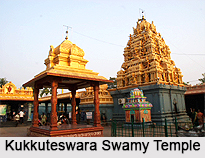 Kukkuteswara Swamy Aalayam Temple is an ancient Shiva temple in Godavari District. It lies in the taluk head quarters town of Pithapuram, lying at a distance of 18 km to Kakinada in the East Godavari district of Andhra Pradesh. It acquired importance of Buddhists, Jains and Vaishnavas also. It was the capital of many local dynasties from about 4th to 5th century AD. It is a visit worthy pilgrim centre, famous in legend and history. The royal family of this town made a mark by patronizing arts and letters, and their contribution for the religious progress too is highly commendable. So its historicity too heightened the glory of this glorious Kshetra.
Kukkuteswara Swamy Aalayam Temple is an ancient Shiva temple in Godavari District. It lies in the taluk head quarters town of Pithapuram, lying at a distance of 18 km to Kakinada in the East Godavari district of Andhra Pradesh. It acquired importance of Buddhists, Jains and Vaishnavas also. It was the capital of many local dynasties from about 4th to 5th century AD. It is a visit worthy pilgrim centre, famous in legend and history. The royal family of this town made a mark by patronizing arts and letters, and their contribution for the religious progress too is highly commendable. So its historicity too heightened the glory of this glorious Kshetra.
Historical Significance of Kukkuteswara Swamy Aalayam Temple
Kukkuteswara Swamy Aalayam Temple is of immense spiritual significance. There is also the legendary Padagaya Tank. The temple campus abounds in many shrines dedicated to Sri Rama, Kumara Swamy, Venkateswara Swamy, Venugopala Swamy and Kunti Madhava Swamy.
Kukkuteswara Swamy, as the presiding deity is called, reveals himself in lingam, and it is a white marble stone of about 2 feet in height. Due to crowing like cock, and the linga resembling the back of cock, Lord Shiva is called `Kukkuteswara Swamy`. He fulfils the desires of devotees without austerities of severe nature. Hence the thronging of devotees is always in large number. It is a Swayambhu lingam and it is believed that water is trickling down into a pot from his nose. This lingam was worshipped by Maharishi Ved Vyasa, Valmiki and Agastya ardently for long.
Pithapuram is famous for one of the Shaktipith. According to Puranas, Sati`s organ fell here when Lord Vishnu cut the corpse borne by Shiva after Dakshasamhara. It became a Shaktipith, and the deity is called `Devi Puruhuthika`. This temple is opposite to the Kukkuteswara Swamy Aalayam Temple.
The Kunti Madhava Swamy temple is adjacent and is one of 5 dedicated to Sri Krishna, called `Madhava`. Kunti is said to have installed the image in this place, and so is called `Kunti Madhava Swamy`.
 Legend of Kukkuteswara Swamy Aalayam Temple
Legend of Kukkuteswara Swamy Aalayam Temple
According to the Puranas, Gayasura- a powerful demon laid his body measuring 125 yajnas by 60 yajnas at the behest of Lord Brahma for doing a great Yajna for Lokakalyana. His head was placed at Gaya in Bihar; his legs reached Pithapuram, thousands of kilometers away. The lake is where his legs are hence it is called Padagaya, a `Tirtha` that relieves all sins, if bathed in.
Festivals at Kukkuteswara Swamy Aalayam Temple
Annual festivals celebrated in this temple are different for different deities like "Maghabahula Ekadasi" for Kukkuteswara, "Suddha Ekadasi" for Kunti Madhava, "Phalguna" for Kumara Swamy and "Karthikamasa" for Venugopala Swamy.





















